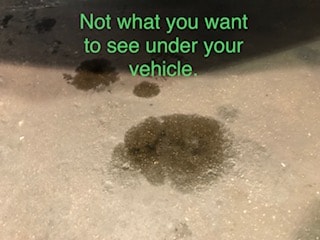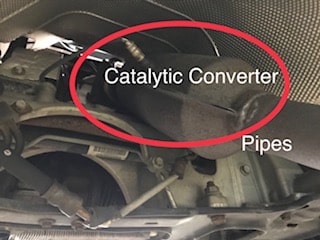Posted on 11/28/2017

Be proactive when you see leaking fluids coming from your vehicle. When you see something:Types of leaks can be: engine oil, engine coolant,transmission fluid, brake fluid washer fluid,Gasoline and more.Some leaks occur while driving, some whilesitting and sometimes during both.Some leaks are common and some are rare.You can often identify your leak by the color,consistency, smell and location.Most common leak? Engine oil.When engine oil is new, it has a yellow golden color,while older oil can be dark brown to black. If you noticethis type of fluid leak, check your oil immediately toprevent major engine damage.
Posted on 11/27/2017
.jpg)
10 Simple ways to get your car ready for winter. 1.Get the right kind of oil change. Oil tends to thicken as it gets colder, if to thick it won’t do the best job of keeping your engine lubricated. Check your cars’ manual. 2.Make sure you can see. Change your blades at least once a year. 3.Give your battery a little TLC. If battery is over three years old, bring it in so we can test it’s ability to hold a charge. Check posts and make sure battery is corrosion free. 4.Examine your belts and hoses. When you come in for an oil change we check all of these. 5.Check your tire pressure. Tires must be inflated properly to ensure best traction. Again, check your manual for optimum tire pressure. 6.Snow tires or all season tires. Depends on the area you live in. Check with your Service Maintenance Shop. 7.4-Wheel drive? Your system should be checked to insure it’s running properly. 8.Get the antifreeze mixture right. Aim for 50/50 mix of antifreeze(coolant) and wa ... read more
Posted on 11/24/2017
.jpg)
Flushing and replacing brake fluid might cost $100 or less on many vehicles, but replacing rusted brake lines and other parts can run several hundreds of dollars, so there is value in keeping the fluid maintained. As we’ve said in the past about maintenance, it’s well worth the effort. In the Braking system itself, there are parts, like the rubber in the valves in the master cylinder, calipers and wheel cylinders deteriorate. When that happens nasty little bits of that flake off and end up in your brake fluid. The fluid becomes old and worn out, moisture gets into the system which leads to rust, adding more nasty bits in your brake fluid. Letting it get dirty and you won’t be stopping as well. A good rule of thumb is to have your brakes flushed about every 30,000 miles or so. Note, brake flushing and bleeding are two different procedures. Brake flushing involves removing all the brake fluid from the system and getting all-new, clean fluid inside. Brake bleedin ... read more
Posted on 11/21/2017
.jpg)
CAR TROUBLE, please have it checked out immediately. When you do that you will be able to prevent any huge damage to your car. There is a reason why the safety system in your car is installed. The system is there to inform you of any problems of mechanical failures your car is having. CAR REPAIR and MAINTENANCE is important. By following preventive maintenance measures, you are able to save time, effort and money. Getting your Engine checked regularly, it’s good to remember that the engine is the heart of the car; busted engine, your car is useless. Don’t forget your transmission, otherwise you may stuck somewhere you would rather not be! Brakes should also be part of your basic car maintenance, remember maintenance of your brakes is an important safety reasons. Low brake fluid levels can cause soft brake pedals. Regular Mechanical inspection should be done and not just a visual inspection of your vehicle, since many components of your car cannot be inspected visually ... read more
Posted on 11/16/2017

EXHAUST SYSTEM What is it? There are no moving parts, but your exhaust system is one of hardest worked parts on the car. It is a series of pipes linking the engine to a muffler and a catalytic converter which performs the following functions; Controls noise. Directs poisonous gases produced in your engine away from you and your passengers and safely out the tailpipe. A poorly functioning exhaust system means lower fuel efficiency, decreased power, and could even lead to costly damage down the line. A malfunctioning exhaust system could mean that those toxic emissions are being piped into your vehicle, where they can do serious damage to your health. Here are some symptoms of a bad or failing exhaust: 1.Excessively noisy engine, one of the first symptoms, it’s a hissing or tapping sound coming from the engine. It may be more pronounced during a cold start. 2.Decrease in power, acceleration, and fuel efficiency-the decreased performance may be minor at first b ... read more
Posted on 11/13/2017
.jpg)
Coolant As the name implies, coolant, aka #antifreeze, keeps your car running cool. If you ever run low on coolant, your car's probably going to overheat. The coolant is inside your radiator and you can typically check it by simply removing the #radiator cap when the car is cool (never check it when it's hot or your car is running) and looking inside. Once you remove the cap you should see a line the coolant should come up to. If it's low, you can add more, but make sure you add the same type of coolant currently in the car. How often to check it: At least twice yearly: once before summer and again before winter But it's easy enough to glance at whenever you pop open your hood. How often to replace it: Every 2-3 years. Most coolants lose their anti-corrosive properties after two years, but anytime you see rusty fluid instead of green, red or orange, it’s time for a c ... read more
Posted on 11/6/2017

The days of periodically checking your #transmission #fluid level by pulling a metal dipstick from a tube alongside your engine are rapidly coming to a close. Many of the New vehicles are doing away with the transmission dipstick and easily accessible tubes for adding fluid to your car’s transmission. One of the main reasons is that the customer can damage their transmission by overfilling or putting in the wrong transmission fluid. The fluids for your vehicle are specific formulas to match the precision internal components of modern transmissions. Using the wrong fluid can cause the transmission to fail long before the car’s new car warranty expires. The manufactures in an effort to protect themselves have made it difficult to service your own transmission. Having said that, your transmission fluid still breaks down, it gets dirty, and still needs to be changed. By not getting your transmission routinely serviced can ... read more
Posted on 11/1/2017
.jpg)
Starting with Engine Oil Chances are, the first thing you ever learned about on your first car was how to check your oil. You have to do this in every car and pretty much every car has the same basic process to check it. Every car though has it in a different place, so double check your manual if you can’t find it. In most cars, you just need to pop up your hood, find the oil dipstick, pull it out, and wipe it down. Repeat that again and you'll have your oil level. If it's in the safe level, continue on your merry way. If it's not, you need to add more(make sure you know what type of oil you should be adding). Depending on the age of the car, you may or may not need to add oil pretty often. If your car burns through a lot of oil, it's worth going to a mechanic. How often to check it: It was once recommended that you check your oil every time you fill up with gas, but with most modern cars you're safe checking it once a month. H ... read more